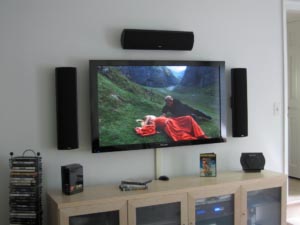
Installing your home entertainment system is often one of the final steps of moving or a renovation project, but the importance of a precise and accurate installation is none-the-less important as is the electrical wiring used to power all your entertainment devices.
In addition to simple, proper installation, there is a certain level of necessary integration that you have to make when installing your TV.
Whether you want it mounted on the wall, hidden in a cabinet, or something a bit more discreet, yet pretty like in a custom box or behind a picture or mirror, there are several things that need to be more than noted, but rather applied.
How large is your TV?
TVs can be big and very heavy. The average flat screen, whether it is LCD, LED or plasma is 42 inches to 55 inches. If purchasing a new TV, or just reinstalling the one you already have, you need to consider the dimensions in regards to placement in your room.
For installation, you should calculate the viewing distance from the TV to figure out how big of a TV you should get, or perhaps where you should sit. The minimum size of you TV should be 1/3 of the viewing distance; the maximum size should be 2/3 of the viewing distance.
Here’s an example to better understand this:
- If you will be sitting 12 feet away you will want a TV with a minimum dimension of 48 inches (12×12=144/3=48) or a TV with a maximum dimension of 96 inches (12×12=144/1.5=96).
 Of course the actual size of TV you get depends on what you can afford and how big of a feature you want the TV to be. After you get your desired TV and figure out where you want your ideal viewing area to be, you can move on to installing the TV.
Of course the actual size of TV you get depends on what you can afford and how big of a feature you want the TV to be. After you get your desired TV and figure out where you want your ideal viewing area to be, you can move on to installing the TV.
Depending on how handy you are, and what how you want the TV displayed, you may choose to hire someone to do it for you. TV installation should not be taken lightly, as previously stated TVs are big and heavy and can be a hazard if not installed correctly.
Here are some guidelines to follow when installing, or having someone install your TV:
- Use the correct mounting equipment. If wall-mounting the TV, make sure you use a bracket that is able to hold and properly support your TV
- If not wall-mounting the TV, make sure the TV stand is stable and will provide enough support. If purchasing a new stand, make sure it can hold a weight greater than what your TV weighs.
- Follow the instructions, simple as that. If installing the TV yourself, follow the directions provided with the TV, TV stand or bracket to ensure correct installation.
- Have someone help you. If installing the TV yourself, have a friend, neighbor or relative help you with the install so you ensure your safety and the proper installation.
- If hiring someone to install your TV, ask the store where you purchased the TV for recommendations, or friends and neighbors who have had theirs installed by a professional.
Getting your TV installed is much easier than you may think. Once you know what you want and where you want it, you can easily and quickly have your TV installed and ready for viewing you favorite programs in no time.
Guest Poster Bio:
Cami is a regular blogger for all things TV, home and family related and regularly posts on Cable.tv. In addition to her love of TV and decoration, Cami also enjoys writing about children’s entertainment and home improvement projects.
Get in Touch With the Gettum Associates Team
Need some help updating your home? Get in touch with us today to arrange a design consultation, or give us a call at 1-317-888-5681.
If you’re ready to get started with a renovation project, you’ll want to download our guide: Seven Questions to Ask When Choosing a Remodeler in the Indianapolis Area.